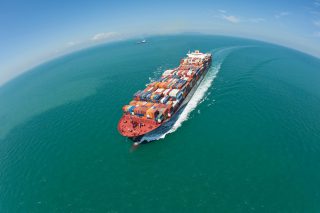 The Ocean Alliance has the most services at its disposal with a total of 40 loops spread across seven East-West trades, a comparison of new carrier alliances from shipping consultancy Drewry shows.
The Ocean Alliance has the most services at its disposal with a total of 40 loops spread across seven East-West trades, a comparison of new carrier alliances from shipping consultancy Drewry shows.
The Ocean Alliance is followed by THE Alliance with 32 services and 2M with 25.
As the market braces for the new alliance networks set to enter the stage on April 1, Drewry compared their respective port coverage, frequency and speed.
The alliances compared are the 2M alliance, comprised of Danish Maersk and Swiss Mediterranean Shipping Company (MSC), Ocean Alliance, made up of French CMA CGM, China’s COSCO, Taiwanese Evergreen and Hong Kong’s Orient Overseas Container Line (OOCL), and THE Alliance, comprised of German Hapag-Lloyd, Taiwanese Yang Ming and three Japanese companies Mitsui O.S.K. Lines (MOL), Nippon Yusen Kaisha (NYK Line) and K Line.
Last week, THE Alliance firmed up the outstanding port decisions to finalize its network for the 1 April start.
Ocean Alliance’s status is primarily due to it having seven Asia-Middle East/Red Sea services, whereas THE Alliance has only one and 2M none. 2M also loses ground in the Asia-West Coast North America with only five services, compared to Ocean Alliance’s 13 services and THE Alliance’s 11, Drewry said.
The Ocean Alliance wins out with the most services in three of the seven trades and joint-most in two others along with 2M. THE Alliance has the most services in just the one trade – Transatlantic – and shares top billing in Med-North America with 2M.
With ship deployment details currently unknown, it does not necessarily follow that having the most services will equal the biggest market share on the trade. 2M’s lack of numerical advantage in services will in many cases be compensated by operating larger ships, the consultancy further said.
Asia port coverage
Central China will have the most weekly departures from the Far East with 131, followed by 118 from the Hong Kong/Taiwan/South China region, 98 from North Asia and 70 from Southeast Asia, Drewry’s data shows.
The most heavily used ports in Asia will be Shanghai (58 weekly departures) and Ningbo (54). Busan has the most departures (32) in North Asia, ahead of Qingdao (25).
North Asia is where the biggest evidence of nationality-bias can be seen as the main customers for Japanese ports will be THE Alliance and its trio of Japanese members.
Yantian will be the busiest port in the South China region with 42 outbound calls, ahead of Hong Kong (26).
In the transshipment-heavy Southeast Asia region, Singapore is the clear winner with 35 outbound weekly calls.
Europe port coverage
Rotterdam will be the busiest port in North Europe with a total of 21 inbound calls each week, followed by Antwerp (19).
In France, Le Havre is the main port of call with 13 inbound voyages per week, while the Ocean Alliance is the only group to venture away with a single call at Dunkirk.
Germany’s calls will be split equally between Bremerhaven and Hamburg (13 each).
2M has the clear edge in Scandinavia/Baltic with calls at three ports, versus only one from Ocean and none by THE Alliance.
In the United Kingdom, Southampton leads the way with 10 inbound calls, closely followed by Felixstowe with 9. London Gateway gets its first deep-sea connections with the decision by THE Alliance to use it for two Asia-North Europe services and two Transatlantic loops.
2M has significantly more port calls in the West Mediterranean with 25 inbound calls, versus 19 from Ocean and 16 from THE Alliance. Thirteen West Med ports will receive alliance ships with the most frequently served being Valencia (10), Barcelona (8), Genoa (8) and La Spezia (7). Strike action at Spanish ports couldn’t have been worse timed for all of the alliance members, Drewry noted.
There will be a total of 42 inbound calls each week in the East Med/Adriatic, spread across 19 ports. Only a handful of ports will get more than two calls each week, with Piraeus being the busiest one with seven calls, according to Drewry.
North America coverage
The South Atlantic of the US will turn around the most alliance services with a total of 72 inbound and 70 outbound calls each week, more than double that of any other region in North America. Norfolk, Savannah and Charleston will be the busiest of the eight South Atlantic ports served by the three carrier groups.
New York-New Jersey will be the main port for services into the North Atlantic, where 2M is conspicuously weaker than its rivals. Instead, 2M’s focus appears to be in the US Gulf region with a total of 12 inbound calls, spread fairly even between the six regional ports. In contrast, the Ocean Alliance has nine weekly US Gulf calls while THE Alliance only has six.
2M also lags behind the other two alliances in the Pacific Southwest and Pacific Northwest. Its 5 PSW calls at Los Angeles-Long Beach and Oakland are well down on the 15 inbound PSW calls from Ocean and 17 from THE Alliance.
Similarly, 2M’s four weekly PNW port calls are dwarfed by eight from THE Alliance and 11 from Ocean, Drewry said.